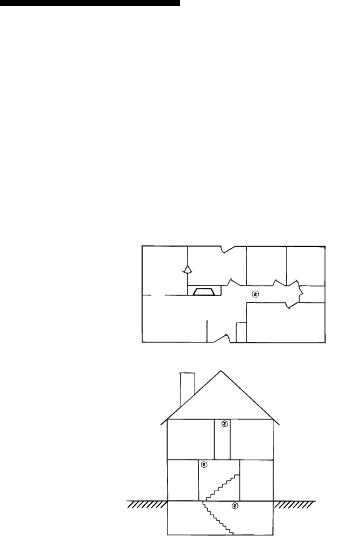
•
The Push-to-Test button accurately tests all smoke alarm
functions. DO NOT use any other test method. Test smoke
alarm weekly to ensure proper operation.
•
Smoke alarms must not be used with detector guards
unless the combination of alarm and guard has been evaluated
and found suitable for that purpose.
•
This smoke alarm should be installed only by a licensed,
qualified electrician. Observe and follow all local and national
electrical and building codes for installation.
•
This smoke alarm IS NOT designed to be the PRIMARY
protection for buildings that require complete fire alarm
systems. Buildings of this type include hotels, motels, dormito-
ries, hospitals, nursing homes, and group homes. This is true
even if they were once single family homes. However, this
smoke alarm MAY be used inside individual rooms as
SUPPLEMENTAL protection.
•
Install a smoke alarm in every room and on every level of the
home. Smoke may not reach the smoke alarm for many reasons.
For example, if a fire starts in a remote part of the home, on another
level, in a chimney, wall, roof, or on the other side of a closed door,
smoke may not reach the smoke alarm in time to alert household
members. A smoke alarm will not promptly detect a fire EXCEPT in
the area or room in which it is installed.
•
Interconnected smoke alarms installed in every room and
on every level of the household offer maximum protection.
The National Fire Protection Agency (NFPA) recommends
interconnecting smoke alarms so that when one smoke alarm
senses smoke and sounds its alarm, all others will sound as
well. Do not interconnect smoke alarms from one individual
family living unit to another. Do not connect this smoke alarm
to any other type of alarm or auxiliary device.
•
Smoke alarms may not alert every household member every
time. There may be limiting circumstances where a household
member may not hear the alarm (e.g., outdoor or indoor noise,
sound sleepers, drug or alcohol usage, the hard of hearing,
etc.). If you suspect that this smoke alarm may not alert a
household member, install and maintain specialty smoke
alarms. Current studies have shown smoke alarms may not
awaken all sleeping individuals, and that it is the responsibility
of individuals in the household that are capable of assisting oth-
ers to provide assistance to those who may not be awakened
by the alarm sound, or to those who may be incapable of safely
evacuating the area unassisted.
•
Smoke alarms can only sound their alarms when they detect
smoke. Smoke alarms detect combustion particles in the air.
They do not sense heat, flame, or gas. This smoke alarm is
designed to give audible warning of a developing fire. However,
many fires are fast-burning, explosive, or intentional. Others are
caused by carelessness or safety hazards. Smoke may not reach
the smoke alarm QUICKLY ENOUGH to ensure safe escape.
•
Smoke alarms have limitations. This smoke alarm is not fool-
proof and is not warranted to protect lives or property from fire.
Smoke alarms are not a substitute for insurance. Homeowners
and renters should insure their lives and property. In addition, it is
possible for the smoke alarm to fail at any time. For this reason,
you must test the smoke alarm weekly and replace every 10
years.
SMOKE ALARM PLACEMENT
Invensys Controls Americas recommends complete coverage pro-
tection achieved by installing a smoke alarm in every room of your
home. The National Fire Protection Association’s (NFPA) minimum
requirement, as stated in Standard 72, Chapter 2, reads as follows:
“2-2.1.1.1 Smoke detectors shall be installed outside of each sepa-
rate sleeping area in the immediate vicinity of the bedrooms and on
each additional story of the family living unit including basements
and excluding crawl spaces and unfinished attics. In new construc-
tion a smoke detector also shall be installed in each sleeping room.”
Chapter 2 also reads as follows:
“2-2.2.1 In new construction, where
more than one smoke detector is
required by 2-2.1, they shall be so
arranged that operation of any
smoke detector shall cause the
alarm in all smoke detectors within
the dwelling to sound.”
The NFPA, 1993 Edition, Appendix A
further states:
“The required number of smoke
detectors may not provide reliable
early warning protection for those
areas separated by a door from the
areas protected by the required
smoke detectors. For this reason, it is
recommended that the householder
consider the use of additional smoke
detectors for those areas for
KITCHEN
DINING
ROOM
BEDROOM
BEDROOM
BEDROOM
LIVING ROOM
BEDROOM BEDROOM
LIVING
ROOM
DINING
ROOM
BASEMENT
HALL
2
110-628F English 11/8/06 11:07 AM Page 2










